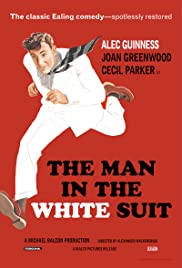
Sidney Stratton (Alec Guinness) is a chemist. A smart one. He has an idea for a new fiber that will repel dirt and last just about forever. The problem is that his demands for money, space and equipment have resulted in his being fired from six textile companies. His last job was working at a menial job for Michael Corland (Michael Gough). While there he siphoned off four thousand pounds to work independently on his project. When Corland finds out Sidney is once again out of a job.
At the employment office he is told that the only opening is in a textile mill owned by Alan Birnley (Cecil Parker). The job is as a common laborer. Birnley’s has a first rate research lab but Sidney doesn’t have access to it. When an electron microscope is delivered to the company someone is needed to help bring it up to the lab. Sidney is assigned the task. The lab technicians mistakenly think that Sidney works for the company that made the microscope. When they realize that Sidney knows far more about the sensitive machine than they do they ask if someone can be assigned to help them along until they get the hang of it. Sidney ends up being an unpaid researcher at the company. Sidney begins working in the lab on his secret project.
Daphne Birnley (Joan Greenwood) is Alan’s daughter. She had been romantically involved with Corland. Corland had been trying to get financing from Daphne’s father when the fiasco with Sidney erupted. Daphne sees Sidney working at her father’s company. Sidney convinces her that what he is doing will revolutionize the textile industry and asks her to not tell her father until he can perfect his formula.
Eventually his experiment works but Sidney is discovered. Daphne comes to his rescue and convinces her father that what Sidney is working on will be worth a lot of money. Alan allows Sidney to continue his experiments until he finally perfects his formula. Synthetic cloth is weaved to create an extremely strong material. A suit is made from the material to fit Sidney. The suit is bright white and has a luminous quality to it. The luminous factor is due to radioactive elements used in the formula.
When the other textile factory big shots and the textile workers find out about the material they are up in arms. A fabric that doesn’t wear out is bad for a business that just makes fabric. Once enough material is made to satisfy consumer demands more material will no longer be needed and the factories will shut down. The workers will lose their jobs and the textile factory owners will not make any more money. All they can do now is to try to get Sidney to sign over his formula so they can bury it and never use it. This doesn’t sit well with Sidney who wanted the material to benefit mankind. In this case, management and labor are in agreement and will do whatever it takes to stop Sidney from making his cloth.
“The Man in the White Suit” was released in 1951 and was written and directed by Alexander Mackendrick. It is a British film and is a science fiction/satire/comedy made by Ealing Studios. Ealing Studios began in 1902 and is the oldest continuously studio in the world. The film is based on a play by Roger MacDougall. It is a lesser known film, at least in the US.
The film is touted as a thought provoking comedy that pokes fun of many of the cultural institutions that Northern England is known for. As Mackendrick himself put it: "Each character in the story was intended as a caricature of a separate political attitude, covering the entire range from Communist, through official Trades Unionism, Romantic Individualism, Liberalism, Enlightened and Unenlightened Capitalism to Strong-arm Reaction. Even the central character was intended as a comic picture of Disinterested Science." I’m quite sure there is a good case for that, but you could also just enjoy it as a pleasant little comedy with some good performances.
The movie is chock full of some great actors, of course the most well known is a very young Sir Alec Guinness. Add to that Joan Greenwood who played Lady Mary Fairchild in “Mysterious Island” 1961. Also in the cast are horror film regulars Michael Gough, the butler Alfred Pennyworth in several of the Batman films, and Ernest Thesiger who is best known as Doctor Pretorius from “Bride of Frankenstein” 1945. This all means the acting is as good as it can get.
The strange noises made by Sidney’s laboratory devise were created by Sound Editor Mary Habberfield, and produced for the soundtrack with a tuba and a bassoon.

